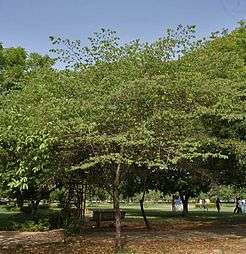Muntingia
| Muntingia | |
|---|---|
_in_Hyderabad%2C_AP_W_IMG_9597.jpg) | |
| Flower close-up. | |
| Scientific classification | |
| Kingdom: | Plantae |
| Clade: | Angiosperms |
| Clade: | Eudicots |
| Clade: | Rosids |
| Order: | Malvales |
| Family: | Muntingiaceae |
| Genus: | Muntingia L. |
| Species: | M. calabura |
| Binomial name | |
| Muntingia calabura | |
| Synonyms[1] | |
| |
Muntingia is a genus of plants in the family Muntingiaceae, comprising only one species, Muntingia calabura.[2] It is native to the neotropics, from Mexico south to Bolivia.
Description
Muntingia calabura is a shrub or tree up to 12 m tall with spreading branches.[3] The leaves are alternate, distichous, oblong or lanceolate, 4–15 cm long and 1–6 cm wide, with toothed margin and covered in short hairs.[3][4][5] The flowers are small (up to 3 cm wide), solitary or in inflorescences of 2-3 flowers; with 5 lanceolate sepals, hairy; 5 obovate white petals; many stamens with yellow anthers and a smooth ovoid ovary.[3][4][5] Fruit, an edible berry, red at maturity, about 1.5 cm wide.[3][4]

Distribution and habitat
M. calabura is native to southern Mexico, the Caribbean, Central America, and western South America south to Bolivia and Argentina.[2][3][6] It is present in tropical climate in disturbed lowland areas from sea level to 1000 m of elevation.[4][2]
Ecology
This species colonize disturbed habitats in tropical lowland areas, becoming part of the secondary vegetation, as well as gallery forests.[3][7] It thrives in poor soil, able to tolerate acidic and alkaline conditions and drought, but doesn't grow on saline conditions.[3]
The seeds are dispersed by birds and fruit bats.[3]
Although native to tropical America, M. calabura has been introduced in Southeast Asia and naturalized there and in other tropical parts of the world.[2][5][8]
Vernacular names
Common names include:
English: calabur tree, capulin, Jamaica cherry, Panama berry, strawberry tree, ornamental cherry, jamfruit tree, Singapore cherry, West Indian cherry.[3][9]
Spanish: cereza, memiso, nigua, bolaina, capulin blanco; chitato, pasito (Colombia); yumanaza, cerezo caspi (Peru).[3][9]
Tagalog: aratiles, datiles, ratiles, latires.[3]
French: bois ramier, cerisier de Panama.[3][9]
Tamil: Sarkarai Pala Maram, Seeni pala maram.[3]
Kannada: gasagase hannina mara.[3]
Vietnamese: trứng cá.[3]
Portuguese: calbura, pao de seda; calabura, curumi, pau de seda (Brazil).[3]
Uses
M. calabura is planted as a source of timber and fuel. Its soft wood used for rural construction, while the bark is fibrous and used for making ropes.[2][7]
The fruits are edible and in some cases sold in markets, as can be eaten raw or processed as jam; leaves can be used for making tea.[3][7] There are also traditional medicinal uses reported for the leaves (headaches, prostate problems, reduce gastric ulcers), bark (antiseptic), flowers (antiseptic, reduce swelling, antispasmodic) and fruits (respiratory problems; antidiarrheic).[2][7][10]
It is planted as an ornamental species;[7] and also because the flowers are a source of nectar and pollen for the beekeeping industry.[7]
The tree is also planted along river banks in Brazil, as fallen fruits attract fish.[2]
M. calabura has a potential as a useful species for restoration of disturbed areas and stop soil erosion.[7] It also offers shelter for wildlife as it is a source of food for ca. 60 species of birds and mammals.[7]
Cultivation
M. calabura can be propagated from seed, seedlings or cuttings.[7] In Costa Rica, seeds set in the wet season, but require conditions of light and temperature found in forest gaps.[11] In a test where seeds were placed in wet paper towel, at 25 °C a total of 44% of seeds germinated in white light, while none germinated in dark conditions.[11]
References
- ↑ "The Plant List: A Working List of All Plant Species". Retrieved 27 December 2014.
- 1 2 3 4 5 6 7 "Neotropical Muntingiaceae - Neotropikey from Kew". www.kew.org. Retrieved 2017-05-16.
- 1 2 3 4 5 6 7 8 9 10 11 12 13 14 15 16 17 18 19 20 Lim, Dr T. K. (2012). "Muntingia calabura". Edible Medicinal And Non Medicinal Plants. 3. Springer Netherlands. pp. 486–492. doi:10.1007/978-94-007-2534-8_62. ISBN 9789400725331.
- 1 2 3 4 Smith Jr., C.E. (1965). "Elaeocarpaceae. In: Flora of Panama, part VI". Annals of the Missouri Botanical Garden. Missouri Botanical Garden. 52 (4): 494–495. doi:10.2307/2394991.
- 1 2 3 Nelson, Gil (2010). The Trees of Florida: A Reference and Field Guide. Pineapple Press Inc. pp. 268–269. ISBN 9781561644759.
- ↑ Boning, Charles R. (2006). Florida's Best Fruiting Plants. Sarasota, Florida: Pineapple Press, Inc. p. 111.
- 1 2 3 4 5 6 7 8 9 Vázquez-Yanes, C.; Batis Muñoz, A. I.; Alcocer Silva, M. I.; Gual Díaz, M.; Sánchez Dirzo, C. (1999). "Muntingia calabura". Árboles y arbustos potencialmente valiosos para la restauración ecológica y la reforestación. Reporte técnico del proyecto J084 (PDF) (in Spanish). CONABIO - UNAM.
- ↑ Hanelt, Peter; Institute of Plant Genetics and Crop Plant Research (2001). Mansfeld's Encyclopedia of Agricultural and Horticultural Crops: (Except Ornamentals). Springer Science & Business Media. p. 1560. ISBN 9783540410171.
- 1 2 3 4 "Muntingia calabura". GRIN-Global Web v 1.9.8.2. U.S. National Plant Germplasm System. Retrieved 2017-05-16.
- ↑ Mahmood, N. D.; Nasir, N. L. M.; Rofiee, M. S.; Tohid, S. F. M.; Ching, S. M.; Teh, L. K.; Salleh, M. Z.; Zakaria, Z. A. (2014). "Muntingia calabura: A review of its traditional uses, chemical properties, and pharmacological observations". Pharmaceutical Biology. 52 (12): 1598–1623. doi:10.3109/13880209.2014.908397. ISSN 1388-0209.
- 1 2 Baskin, Carol C.; Baskin, Jerry M. (2001). Seeds: Ecology, Biogeography, and Evolution of Dormancy and Germination. Elsevier. pp. 259, 275. ISBN 9780120802630.